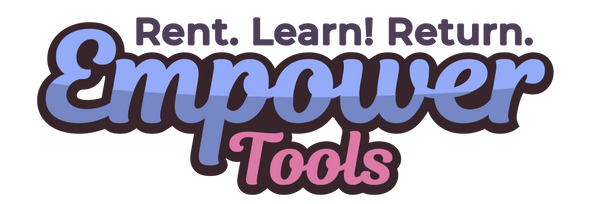Getting Started with Power Tools: Building Tool Fluency
Share
Here at Empower Tools, we talk a lot about "tool fluency" as our fundamental goal for our customers. Tool fluency means an understanding, proficiency, and a deep connection with your tools, allowing you to wield them effectively and creatively. Cultivating tool fluency enhances your quality, productivity, and enjoyment of the project. In this guide, we'll explore what tool fluency entails and how you can cultivate it to elevate your skills and confidence.
Understanding Tool Fluency
Tool fluency is akin to mastering a musical instrument - it involves:
- Knowledge: Understanding the capabilities, functions, and limitations of each tool in your arsenal.
- Skill: Proficiency in using tools to achieve precise cuts, joints, and finishes, translating your vision into tangible creations
- Intuition: Developing a sense of how each tool behaves, anticipating adjustments needed for different materials and projects.
Steps to Cultivate Tool Fluency
1) Study Your Tools
- Info Cards: We provide an info card for every tool. These cards show you all the elements of the tool, including things as basic as how to remove the battery. The back of the card offers tips for success and solutions to common issues.
- Videos: We also offer more in-depth versions of the info cards as well as a library of links to knowledgeable creators across the internet.
2) Hands-On Practice
- Start Small: Begin with basic projects to hone fundamental skills such as measuring, cutting, drilling, and sanding. Our project bundles are built with incremental skill building in mind to help you avoid the guesswork out of what's next.
- Experiment: Practice using different settings, angles, and techniques to understand how each adjustment impacts the outcome.
3) Safety First
- Use PPE: Always wear appropriate Personal Protective Equipment (PPE) such as safety glasses, hearing protections, and dust masks to protect yourself from potential hazards. We offer a PPE kit and new customers get one free with their first order!
- Tools: Identify all safety guards and mechanisms on your tools and do not bypass them. Understand how the tools interacts with the material to avoid kickback and losing control.
4) Explore Versatility
- Tool Mastery: Practice using tools in various scenarios to develop versatility and adaptability in different woodworking projects.
5) Refine Techniques
- Precision: Focus on achieving precise cuts, joints, and finishes through deliberate practice and attention to detail.
- Efficiency: Strive to work efficiently by optimizing tool setups, workflow processes, and time management skills.
6) Learn from Others
- Join Communities: Participate in woodworking clubs, forums, or workshops to learn from experienced craftspeople, share insights, and receive constructive feedback.
Benefits of Tool Fluency
- Quality Artisanship: Achieve higher quality results with clean cuts, seamless joints, and fine finishes.
- Cost Efficiency: By completely projects more accurately, you go through less stock and spend less on fixes.
- Creativity: Experiment with new techniques and designs, confidently exploring your creative potential.
- Confidence: Fight imposter syndrome and take on increasingly challenging projects
Conclusion
Tool fluency is a journey of continuous learning and improvement. By investing time in studying your tools, gaining hands-on experience, prioritizing safety, and seeking guidance from the community, you'll gradually develop mastery and confidence in using your tools effectively. Embrace challenges, learn from mistakes, and celebrate achievements as you embark on the path to becoming fluent in the language of power tools. Let us guide you and enjoy the journey of creating beautiful and functional pieces with skill and precision. Now get out there and build some stuff!
